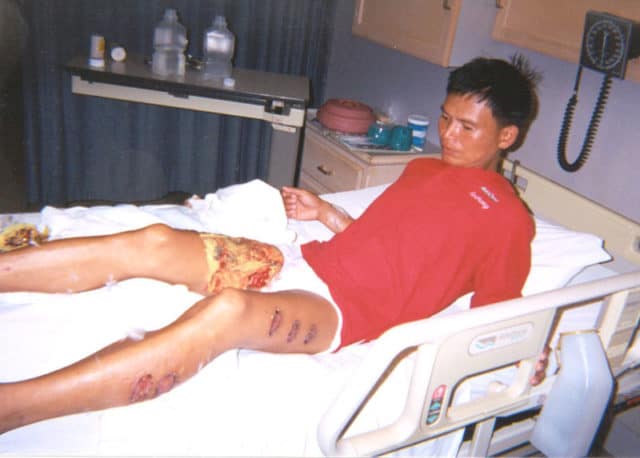Torture

On June 2nd, 2001, three labor camp guards tried to force Tan Yongji (above) to sign a repentance statement renouncing Falun Gong. When he refused, the guards tied him to a post, heated an iron rod in a furnace until it glowed red, and began applying it to his legs. The pain was so excruciating that Tan lost control of his bowel and bladder functions. The guards pressed the rod on his legs 13 times, spacing them out at regular intervals on his flesh, asking him all the while if he would renounce his belief in Falun Gong.
Torture in custody has taken the lives of thousands of Falun Gong practitioners since the Communist Party began persecuting followers of the spiritual discipline in 1999.
While cases of torture are annually documented in nearly every country around the world, the Falun Gong represent one of the largest and most frequently tortured groups. In the United Nations’ Special Rapporteur on Torture’s 2006 report, for instance, two thirds of the torture cases listed for China were of Falun Gong.
Human rights organizations have documented over 87,000 cases of severe abuse or torture of Falun Gong adherents. Of the more than 3,400 confirmed deaths of Falun Gong adherents in China, the vast majority came from torture.
Used for decades by Chinese Communist Party police to extort confessions from suspects and targets of political campaigns, torture is now being used against the Falun Gong to force them to renounce their faith. Both physical and mental torture techniques are used (see Psychological Abuse section), though the distinction between the two is not always clear.
The way mental and physical torture are combined can be seen in the brief excerpt below from the Washington Post, which describes the typical ordeal countless Falun Gong adherents have faced:
At a police station in western Beijing, Ouyang was stripped and interrogated for five hours. “If I responded incorrectly, that is if I didn’t say, ‘Yes,’ they shocked me with the electric truncheon,” he said.
Then, he was transferred to a labor camp in Beijing’s western suburbs. There, the guards ordered him to stand facing a wall. If he moved, they shocked him. If he fell down from fatigue, they shocked him.
Each morning, he had five minutes to eat and relieve himself. “If I didn’t make it, I went in my pants,” he said. “And they shocked me for that, too.”
By the sixth day, Ouyang said, he couldn’t see straight from staring at plaster three inches from his face. His knees buckled, prompting more shocks and beatings. He gave in to the guards’ demands.
For the next three days, Ouyang denounced [Falun Gong’s] teachings, shouting into the wall. Officers continued to shock him about the body and he soiled himself regularly. Finally, on the 10th day, Ouyang’s repudiation of the group was deemed sufficiently sincere.
He was taken before a group of Falun Gong inmates and rejected the group one more time as a video camera rolled. Ouyang left jail and entered the brainwashing classes. Twenty days later after debating Falun Gong for 16 hours a day, he “graduated.”
(John Pomfret and Philip P. Pan, August 5, 2001, full article)
Human rights workers have also compiled over 100 methods of corporal torture methods used against the Falun Gong. Below are a few short examples of such methods. More detailed examples can be found through the index on the right.
Beatings
Falun Gong practitioners in police custody are often brutally beaten, sometimes to death. The use of the following items for beating have been documented among the known cases: wooden clubs, steel and iron bars, iron rods, whips made of twisted copper wire, bamboo sticks, rubber sticks, electric batons, wooden planks, steel wire locks, rattan, electric wire whips and rope whips.
Piercing
Fingertips are pierced with pins and bamboo nails, which are also hammered under the fingernails. In many cases, torturers pull out the practitioners’ fingernails by the root. Women’s breasts are also pierced with sharp wires.
Force-feeding
Force-feeding is a torture method often used on the Falun Gong, and it has been the cause of death in approximately 10 percent of all known death cases. The force-feeding is most often carried out by labor camp staff with no medical training, or by criminal inmates who are coerced to assist. Unsanitary rubber tubes are shoved into an adherent’s nose and down the stomach, often rupturing or damaging tissue; sometimes the tube enters the lungs. Detainees are often fed irritants such as highly concentrated salt water, hot pepper oil, boiling water, detergent, or even human feces.
Scorching with Hot Irons
Hundreds of practitioners have reported being burned with cigarettes, lighters, fire, irons, or hot iron bars.
“Water Dungeon”
In “Water Dungeons,” the detainee spends many days in total darkness while inside a small cage and immersed in chest deep water. Often the water is routed from sewage lines. Some detainees have died under such conditions, while others have been driven insane from this torture.
High-voltage Electric Shock Batons
Electric batons carrying high voltages are used to shock practitioners’ sensitive areas and private parts such as the inside of the mouth, top of the head, breasts, genitals, buttocks, thighs, etc. Several electric batons are often used simultaneously on different parts of the body. Victims have said that the smell of burning flesh permeates the air during the torture.
For more information and documentation of recent torture cases, see:
- Falun Dafa Information Center 2008 Annual Report: Chapter on Torture and Other Cruel, Inhuman, or Degrading Treatment
- Falun Dafa Information Center 2010 Annual Report: Chapter on Torture and Other Forms of Inhumane Treatment






